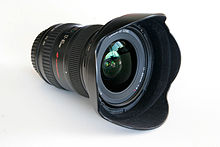
Back Wyehoeklens Afrikaans عدسة واسعة الزاوية Arabic Gran angular Catalan Širokoúhlý objektiv Czech Vidvinkelobjektiv Danish Weitwinkelobjektiv German Objetivo gran angular Spanish Objektibo angeluhandi Basque لنز واید Persian Laajakulmaobjektiivi Finnish


In photography and cinematography, a wide-angle lens is a lens covering a large angle of view.[a] Conversely, its focal length is substantially smaller than that of a normal lens for a given film plane. This type of lens allows more of the scene to be included in the photograph, which is useful in architectural, interior, and landscape photography where the photographer may not be able to move farther from the scene to photograph it.
Another use is where the photographer wishes to emphasize the difference in size or distance between objects in the foreground and the background; nearby objects appear very large and objects at a moderate distance appear small and far away.
This exaggeration of relative size can be used to make foreground objects more prominent and striking, while capturing expansive backgrounds.[1]
A wide-angle lens is also one that projects a substantially larger image circle than would be typical for a standard design lens of the same focal length. This large image circle enables either large tilt & shift movements with a view camera.
By convention, in still photography, the normal lens for a particular format has a focal length approximately equal to the length of the diagonal of the image frame or digital photosensor. In cinematography, a lens of roughly twice the diagonal is considered "normal".[2]
Cite error: There are <ref group=lower-alpha> tags or {{efn}} templates on this page, but the references will not show without a {{reflist|group=lower-alpha}} template or {{notelist}} template (see the help page).
- ^ "Using wide angle lenses". Cambridge in Colour. Retrieved 27 December 2011.
- ^ Anton Wilson, Anton Wilson's Cinema Workshop, American Cinematographer, 2004 (Page 100) ISBN 0-935578-26-9
© MMXXIII Rich X Search. We shall prevail. All rights reserved. Rich X Search